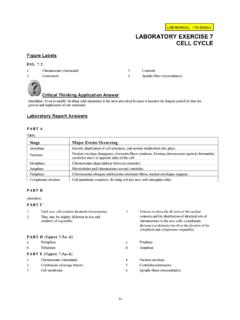Transcription of Cell$Division$ - Virginia Department of Education …
1 Science Enhanced Scope and Sequence Life Science Virginia Department of Education 2012 1 cell division Strand Life Systems Topic Investigating mitosis and meiosis Primary SOL The student will investigate and understand that all living things are composed of cells . Key concepts include a) cell structure and organelles; b) similarities and differences between plant and animal cells ; c) development of cell theory; and d) cell division . Related SOL The student will investigate and understand that living things show patterns of cellular organization.
2 Key concepts include b) patterns of cellular organization and their relationship to life processes in living things. Background Information When introducing cell division to students, remind them that all cell organelles are present and performing their usual tasks. cell division perpetuates life and allows for growth and reproduction of organisms. cells go through a life cycle known as the cell cycle. The phases of the cell cycle are interphase, mitosis , and cytokinesis.
3 During interphase, the cell cycle s first phase, the cell grows to its mature size, makes a copy of its DNA, and prepares to divide into two cells . Interphase takes the most time to complete during the cell division process. The second phase of the cycle is mitosis . During mitosis , the cell s nucleus divides into two new nuclei, and one copy of the DNA is distributed into each of the two daughter cells . During the final phase of the cell cycle, cytokinesis, the cytoplasm divides, distributing the organelles into each of the two new cells .
4 The purpose of meiosis is to produce reproductive (sex) cells that carry half the genetic material of the parent. During meiosis, the chromosome pairs separate and are distributed to two different cells . The resulting sex cells have only half as many chromosomes as the other cells in the organism. Materials Colored chalk Colored pencils Microscopes Onion root tip slides Diagrams of mitosis and meiosis Copies of handouts: Stages of mitosis , mitosis in Onion cells , and Meiosis (attached) Vocabulary anaphase, cell, chromosomes, cytokinesis, cytoplasm, interphase, meiosis, metaphase, mitosis , nucleus, organelles, prophase, replication, telophase Science Enhanced Scope and Sequence Life Science Virginia Department of Education 2012 2 Student/Teacher Actions (what students and teachers should be doing to facilitate learning) 1.
5 Use colored chalk or markers to draw the stages of mitosis on the board, using different colors for the chromosomes. Label each stage and the structures you have drawn. Then, go through each stage with students, describing the changes from one stage to the next. Give each student the Stages of mitosis handout. Have students use colored pencils to draw each stage of mitosis as depicted in your drawing. Have them write a description of what happens at each stage.
6 2. Divide the class into pairs of students, and have each pair look at the onion root tip slide through the microscope and locate the different stages of mitosis . Have students use colored pencils to draw and label these actual stages of mitosis that they observe. Have students complete the mitosis in Onion cells handout. 3. Discuss the difference between mitosis and meiosis. Give each student a Meiosis handout. Make it clear that during meiosis, the chromosome pairs separate and are distributed to two different cells .
7 The resulting sex cells have only half as many chromosomes as the other cells in the organism. Show diagrams of the stages of meiosis to compare to the stages of mitosis . Assessment Questions o Why must your body make new cells ? o What is the cell cycle? o What is mitosis ? o Where along the root tip do the cells undergo mitosis ? o Which stage of mitosis is seen most frequently in a cell undergoing mitosis ? Why? Journal/Writing Prompts o Describe and illustrate the phases of the cell cycle.
8 O Compare and contrast mitosis and meiosis. o Select a phase of mitosis or meiosis. If the phase were to be interrupted or disturbed in an organism, describe the impact (using scientific terms) you predict would occur for the organism. Extensions and Connections (for all students) Have students act out the phases of mitosis , using pool noodles to represent chromosomes. Have students prepare and present to class, posters of the phases of mitosis , using colored yarn to represent the chromosomes.
9 Strategies for Differentiation Display The mitosis Song, and have students sing it. Science Enhanced Scope and Sequence Life Science Virginia Department of Education 2012 3 The mitosis Song (sung to the tune of London Bridge Is Falling Down ) In mitosis cells divide, cells divide, cells divide. In mitosis cells divide, for cell reproduction. In interphase chromosomes duplicate, duplicate, duplicate. In interphase chromosomes duplicate, in mitosis . In prophase we see chromosomes, see chromosomes, see chromosomes.
10 In prophase we see chromosomes, in mitosis . In metaphase chromosomes all line up, all line up, all line up. In metaphase chromosomes all line up, in mitosis . In anaphase chromosomes move apart, move apart, move apart. In anaphase chromosomes move apart, in mitosis . In telophase there are two nuclei, two nuclei, two nuclei. In telophase there are two nuclei, in mitosis . In cytokinesis there are two new cells , two new cells , two new cells . In cytokinesis there are two new cells , in mitosis .
















